Redefining Learning: The Revolutionary Impact of AI in Education
Artificial Intelligence (AI) is progressively becoming a transformative force in education, altering the landscape of teaching and learning processes across the globe. By integrating AI technologies into educational systems, educators and institutions can offer more personalized, accessible, and engaging learning experiences. This introduction provides an overview of AI’s impact and potential in education, highlighting how AI technologies are revolutionizing traditional educational practices and paving the way for a new era of personalized learning.
1. AI’s Impact and Potential in Education
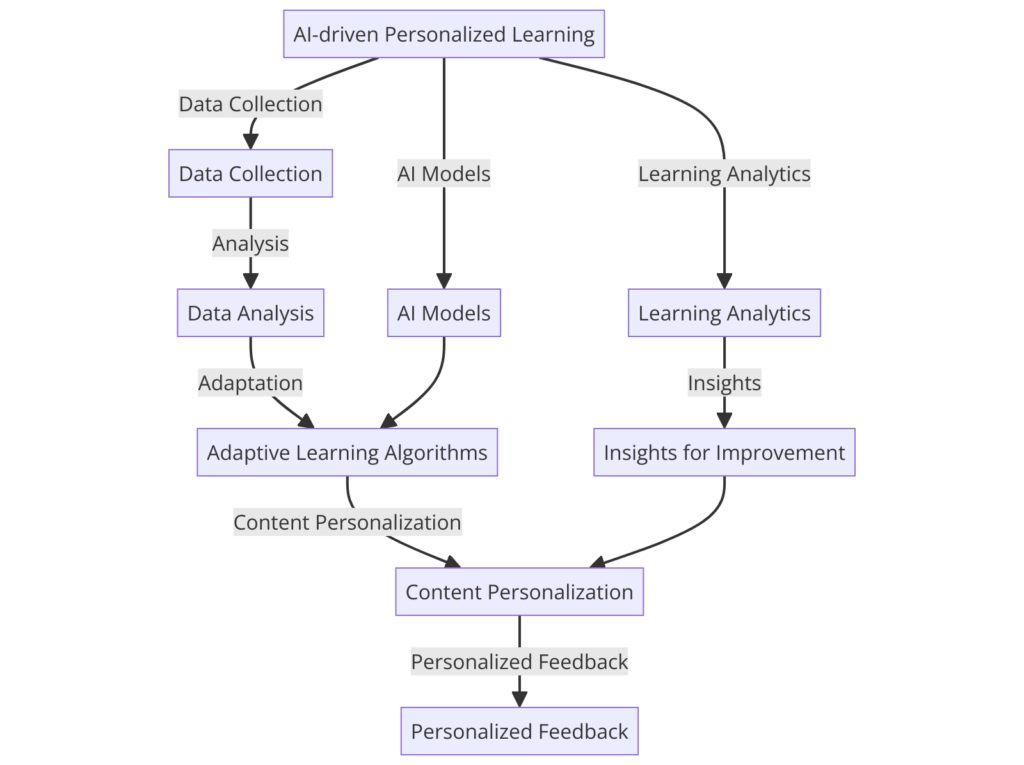
Overview of AI’s Impact and Potential in Education
AI in education encompasses many applications, from personalized learning platforms and intelligent tutoring systems to automation of administrative tasks and enhancement of teaching methods.
These AI-driven solutions can adapt to student’s learning paces and styles, provide real-time feedback and support, and free up educators’ time for more interactive and creative teaching activities.
The potential of AI to democratize education, making high-quality learning resources more accessible to students worldwide, is among its most promising aspects.
How AI is Transforming Teaching and Learning Processes
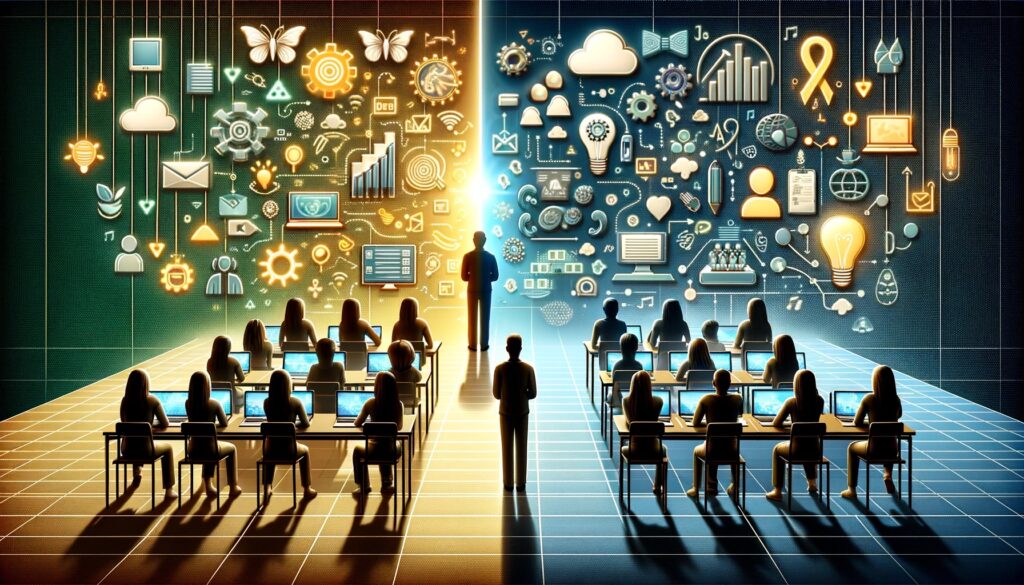
- Personalized Learning: AI enables the creation of adaptive learning systems that adjust content, pace, and complexity based on the learner’s performance and preferences, offering each student a tailored educational experience.
- Efficiency in Administration: Through the automation of administrative tasks, AI technologies can streamline operations within educational institutions, reducing workload and allowing for more efficient management of resources.
- Enhanced Assessment Methods: AI tools are revolutionizing grading and assessment by providing more objective and timely evaluations of student work alongside valuable analytics on student performance and learning outcomes.
- Innovative Teaching Aids: AI-powered tools and resources support educators in enhancing their teaching methods, whether through interactive content, data-driven insights into student engagement, or facilitating remote learning environments.
The impact of AI in education is profound, offering the potential to transform educational systems into more personalized, efficient, and inclusive environments.
As AI technologies continue to evolve, their integration into education promises to enhance teaching and learning processes further, making education more adaptive and accessible.
The journey of AI in education is not merely about adopting new technologies but about reimagining the future of education in an increasingly digital world.
2. AI in Personalized Learning

The advent of AI in education has ushered in a new era of personalized learning, where teaching methods and materials are tailored to each student’s individual needs, abilities, and learning styles.
AI-driven adaptive learning systems leverage data analytics and machine learning algorithms to create customized educational experiences, enhancing student engagement and learning outcomes.
Exploring AI-driven Adaptive Learning Systems
Adaptive learning systems powered by AI analyze real-time data on students’ interactions, performance, and feedback to adjust the learning path and content accordingly.
These systems can identify students’ strengths and weaknesses, adapt to the difficulty level, and suggest resources that target specific learning gaps.
- Dynamic Content Adjustment: AI algorithms dynamically modify learning content based on student performance, ensuring students are both well-rested and able to handle their challenges.
- Predictive Analytics: By analyzing patterns in student data, AI can predict potential learning outcomes and provide early interventions for students who may be at risk of falling behind.
- Interactive and Engaging Learning: AI-driven systems often incorporate gamification and interactive elements, making learning more engaging and motivating for students.
Case Studies of Personalized Learning Experiences Enhanced by AI
- Carnegie Learning’s MATHia: MATHia, an AI-powered math learning platform, offers personalized math instruction. It adapts to each student’s learning pace and style, providing real-time feedback and hints that guide them through problem-solving processes. Schools using MATHia have reported significant improvements in math scores.
- Content Technologies, Inc. (CTI): CTI utilizes AI to create custom textbooks that match the curriculum needs and learning objectives of specific courses and students. CTI’s AI generates textbooks tailored to the course’s unique requirements by analyzing existing course materials and educational standards.
- Duolingo: The popular language learning app Duolingo uses AI to tailor lessons to the learner’s proficiency level, optimizing the pace and content of language learning. Its AI algorithms analyze performance data to customize review sessions, ensuring learners strengthen their weak areas.
AI in personalized learning represents a significant shift in educational paradigms, moving away from one-size-fits-all approaches and embracing each learner’s unique differences.
By leveraging AI-driven adaptive learning systems, educators can provide more personalized, effective, and engaging learning experiences.
These technologies support students in achieving better academic outcomes and foster a love for learning by making education more relevant and interactive.
As AI technology advances, its potential to further personalize and revolutionize education is boundless, promising a future where all students can achieve their full potential.
3. AI in Educational Administration

Integrating Artificial Intelligence (AI) into educational administration is streamlining operations, enhancing efficiency, and reducing the workload of academic staff.
By automating routine administrative tasks, AI allows educational institutions to allocate more resources toward teaching and student support.
Automating Administrative Tasks Using AI
AI technologies, including machine learning algorithms and natural language processing, are adept at handling administrative tasks that traditionally require considerable time and effort. These tasks range from student enrollment processes to scheduling and resource allocation.
- Enrollment and Admissions: AI systems can automate the processing of admissions applications, analyzing documents and data to streamline student enrollment. This speeds up the admissions process and ensures fairness and objectivity in student selection.
- Scheduling and Timetabling: AI algorithms optimize class schedules and exam timetables, considering room availability, faculty schedules, and student needs. This optimization reduces conflicts and maximizes resource efficiency.
- Resource Allocation: AI helps in the strategic allocation of resources, from budgeting to the distribution of teaching materials. It ensures that resources are utilized effectively to meet the institution’s goals and enhance student learning outcomes.
Improving Efficiency in Educational Institutions
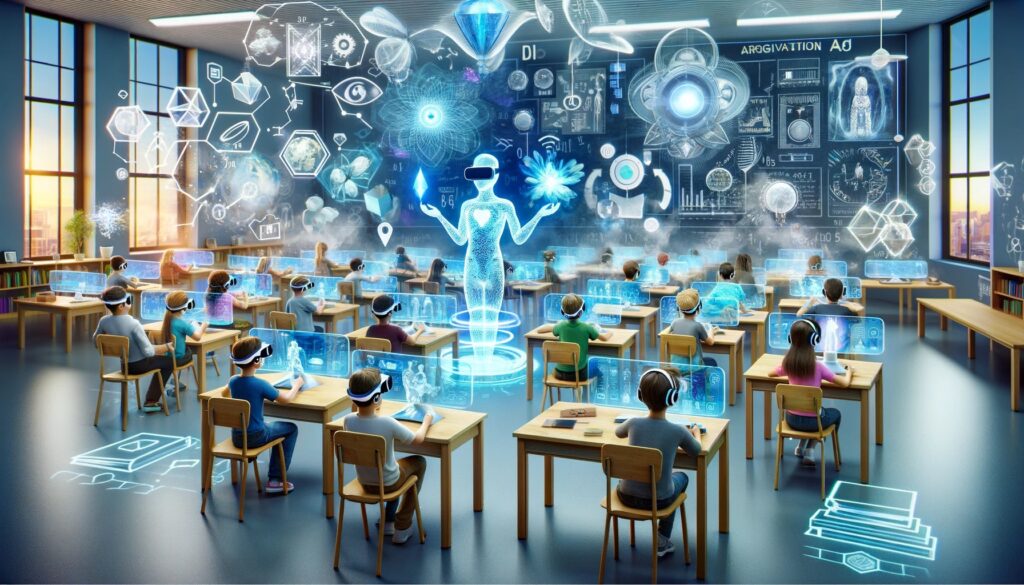
The application of AI in administrative processes significantly improves operational efficiency within educational institutions. By reducing the administrative burden, academic staff can focus more on student engagement and pedagogical innovation.
- Data-Driven Decision Making: AI tools analyze institutional data to provide insights that inform decision-making, from identifying trends in student performance to predicting future resource needs. This data-driven approach supports more effective planning and management.
- Enhanced Communication: AI-powered chatbots and virtual assistants handle inquiries from students, parents, and staff. They immediately respond to common questions and free human resources for more complex queries and interactions.
- Cost Reduction: Automating administrative tasks with AI can lead to substantial cost savings, reducing the need for manual processing and allowing institutions to allocate their budgets more effectively toward educational priorities.
AI’s role in educational administration is transforming how institutions operate, making them more efficient, responsive, and focused on their core mission of education.
As AI technologies continue to advance, their potential to further streamline administrative processes and improve the operational efficiency of educational institutions is vast.
By embracing AI, academic institutions can enhance their administrative capabilities, enabling a more effective and focused approach to teaching and learning.
4. AI in Grading and Assessment

Implementing Artificial Intelligence (AI) in grading and assessment is revolutionizing how educators evaluate student work, offering more efficient, objective, and comprehensive analysis.
AI-driven systems automate the grading process for various evaluations, from multiple-choice tests to complex essays and projects.
This automation reduces the workload for educators and provides valuable insights into student learning patterns and performance.
Role of AI in Automating Grading
- Automated Essay Scoring: AI algorithms can evaluate written assignments, analyze grammar and syntax, and even ensure the coherence of arguments. These systems use natural language processing to assess essays on a scale comparable to human graders, providing immediate feedback to students.
- Objective Assessment of Open-ended Responses: Beyond essays, AI systems assess open-ended responses in subjects like mathematics and science, interpreting student input to evaluate reasoning and problem-solving skills accurately.
- Real-time Feedback and Personalized Learning Insights: AI-driven assessment tools offer real-time feedback to students, identifying areas of strength and weakness. This immediate response facilitates a more dynamic learning process, allowing students to adjust their study strategies accordingly.
Impact on Educators’ Workload and Assessment Quality
- Reduced Grading Time: AI automates the grading process, significantly reducing the time educators spend evaluating student work and freeing them to focus on teaching, curriculum development, and individual student support.
- Consistency and Objectivity in Grading: AI systems provide consistency and objectivity in grading that is challenging to achieve manually, especially with large classes. This consistency ensures that all students are evaluated by the same standards, enhancing the fairness of the grading process.
- Enhanced Assessment Analytics: AI tools analyze assessment data to identify trends and patterns in student performance, offering educators insights that can inform instruction and curriculum adjustments. These analytics can highlight areas where students struggle, allowing for targeted interventions.
Integrating AI in grading and assessment transforms educational assessment, making it more efficient, objective, and insightful.
While the technology has challenges, including ensuring the accuracy and fairness of AI grading systems, the potential benefits are significant.
As AI technology continues to evolve, its application in education promises to reduce educators’ administrative burdens and enhance the learning experience for students.
The future of AI in grading and assessment lies in its ability to complement human judgment, providing tools that support educators in delivering high-quality, personalized education.
5. AI in Enhancing Teaching Methods
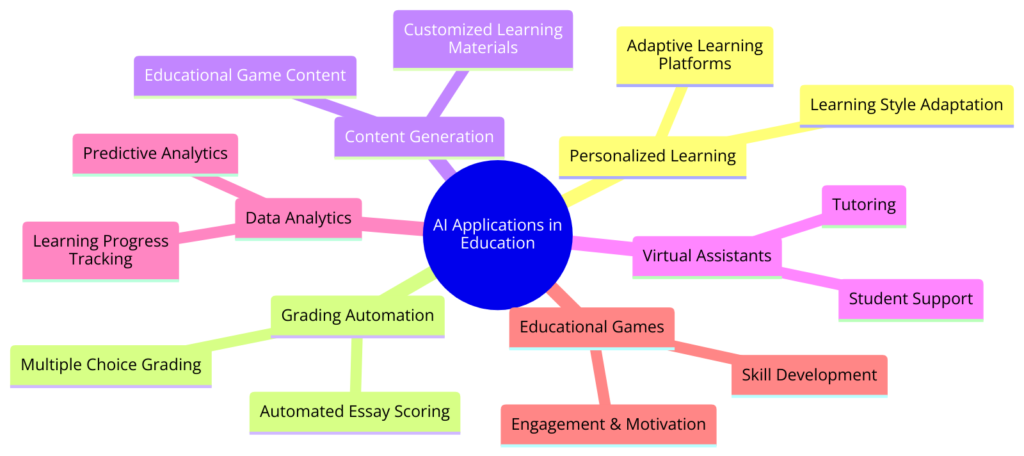
AI in education is reshaping administrative and assessment aspects by significantly enhancing teaching methodologies.
By providing educators with advanced tools and insights, AI supports more effective teaching strategies, enabling personalized instruction and interactive learning experiences.
AI Tools for Supporting Teaching Methodologies
- Intelligent Tutoring Systems (ITS): These AI-driven platforms offer personalized tutoring to students, adjusting the difficulty level and content based on individual learning progress. ITS can mimic one-on-one tutoring experiences, providing explanations, feedback, and encouragement tailored to each student’s needs.
- Content Generation and Augmentation: AI can generate educational content, such as quizzes, interactive simulations, and visual aids, enriching the curriculum and providing diverse learning materials. This content is often dynamically adjusted to match students’ learning pace and style, enhancing engagement and comprehension.
- Predictive Analytics for Early Intervention: By analyzing student performance data, AI tools can identify students who may be at risk of falling behind or disengaging. This allows educators to intervene early, providing additional support or adjusting teaching strategies to address specific challenges.
Examples of AI in Classroom and Remote Learning
- Duolingo and Language Learning: Duolingo’s AI-driven platform personalizes language learning, adapting lessons based on user performance. Its speech recognition feature provides immediate feedback on pronunciation, facilitating language acquisition in remote settings.
- Khan Academy’s Personalized Learning Paths: Utilizing AI, Khan Academy offers personalized learning paths across subjects, allowing students to progress at their own pace while ensuring mastery of each concept through adaptive practice exercises and instructional videos.
- Zoom’s AI Features for Remote Learning: In response to the shift toward remote education, Zoom has integrated AI features like automatic transcription, real-time translation, and engagement analytics to enhance the virtual classroom experience and make remote learning more accessible and interactive.
Balancing AI Integration with Traditional Teaching Methods
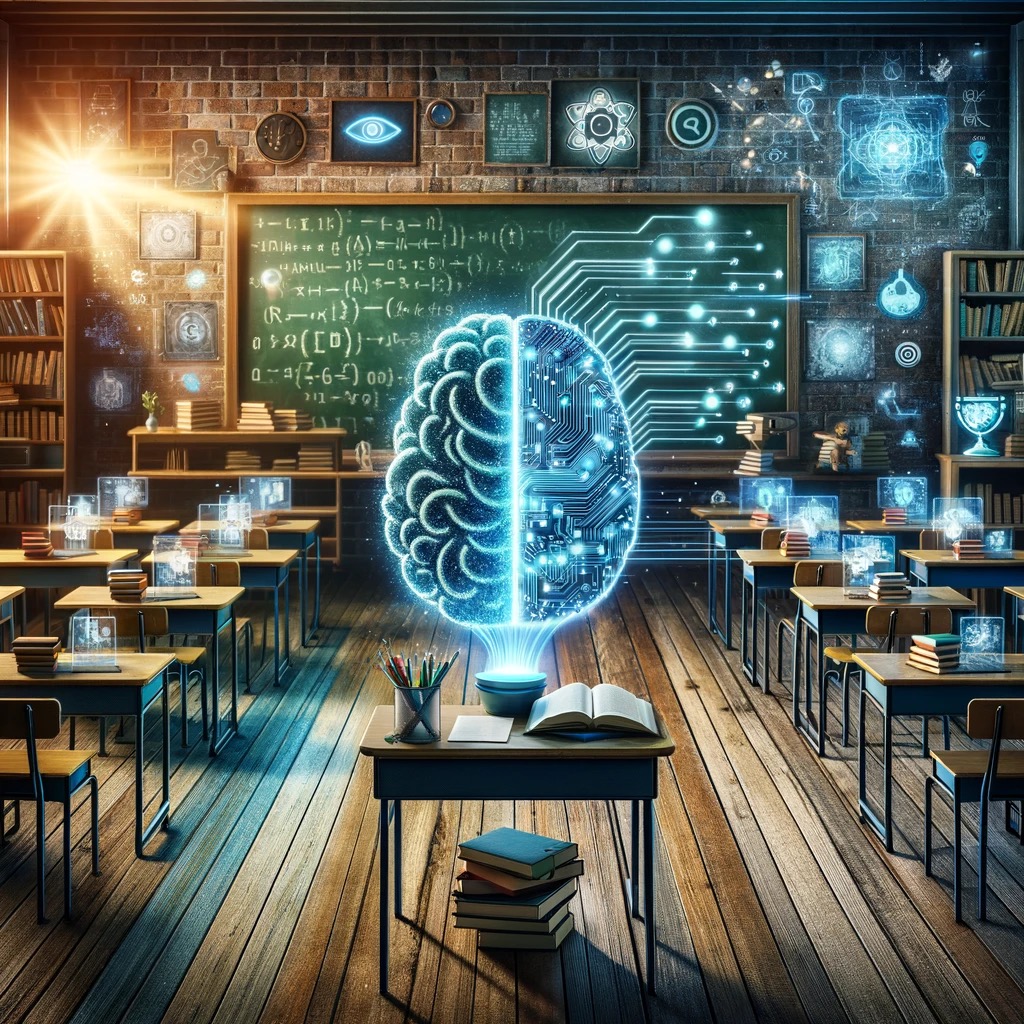
While AI in education offers powerful tools for enhancing teaching methodologies, it is crucial to balance its integration with traditional, human-centric teaching approaches.
Effective education relies on the empathy, intuition, and interpersonal connections only human educators can provide.
Combining AI’s capabilities with the irreplaceable value of human teaching creates a hybrid model where technology supports and amplifies the educational experience rather than replacing it.
AI’s integration into teaching methodologies presents an opportunity to transform educational practices, making learning more personalized, engaging, and effective.
By leveraging AI tools and insights, educators can enhance their teaching strategies, better meet students’ diverse needs, and prepare them for success in an increasingly digital world.
As AI technologies continue to evolve, their potential to support and augment teaching methodologies will undoubtedly expand, offering exciting possibilities for the future of education.
6. Challenges and Ethical Considerations in AI-driven Education

Integrating Artificial Intelligence (AI) into education brings forth a spectrum of challenges and ethical considerations that must be navigated carefully.
While AI has the potential to enhance learning experiences and operational efficiency significantly, issues surrounding data privacy, access inequality, and the balance between automated instruction and human interaction remain pivotal concerns.
Addressing these challenges is crucial for ensuring AI’s responsible and equitable use in educational settings. This section delves into AI-driven education’s main challenges and ethical dilemmas.
Addressing Data Privacy and Security
- Sensitive Data Handling: AI systems in education often process sensitive student data, including performance metrics, behavioral patterns, and personal information. Ensuring the privacy and security of this data against breaches is paramount.
- Consent and Transparency: There must be clear policies regarding data collection, use, and sharing within AI educational tools, with explicit consent from students and guardians. Transparency in AI algorithms’ decision-making processes is also essential to maintaining trust.
Navigating Access Inequality
- Digital Divide: The reliance on AI-driven educational tools can exacerbate existing inequalities in access to technology and high-speed internet. Ensuring equitable access to AI-enhanced learning resources prevents further educational disparities.
- Bias in AI Algorithms: AI systems can inherit biases from their training data, potentially leading to unfair or discriminatory educational outcomes. Rigorous testing and bias mitigation strategies are necessary to ensure AI tools support equitable education.
Balancing AI Automation with Human Interaction
- The Role of Educators: While AI can automate specific teaching tasks and personalize learning, the irreplaceable value of human teachers in mentoring, providing emotional support, and fostering critical thinking must be preserved. Balancing AI’s capabilities with the human elements of teaching is essential.
- Student Engagement: Ensuring that AI-driven learning maintains or enhances student engagement is challenging. Personalized learning paths must keep students motivated and actively involved in their education.
Ethical AI Development and Deployment
- Ethical Frameworks: Developing and adhering to ethical frameworks for AI in education is necessary to guide the responsible creation and implementation of AI tools, focusing on student welfare, equity, and inclusion.
- Stakeholder Involvement: Engaging a wide range of stakeholders, including educators, students, parents, and ethicists, in the development and deployment of AI educational tools can help address ethical concerns and ensure that these technologies meet the diverse needs of the educational community.
The challenges and ethical considerations of integrating AI into education highlight the complexity of leveraging technology to enhance learning while safeguarding data privacy, ensuring equitable access, and maintaining the essential human elements of education.
By addressing these concerns through responsible AI development, transparent policies, and inclusive practices, the educational sector can harness AI’s benefits to enrich teaching and learning experiences without compromising ethical standards or educational equity.
7. The Future of AI in Education

The evolving role of AI in education is shaping a future where personalized learning, administrative efficiency, and innovative teaching methodologies become increasingly integrated into educational experiences.
As technology advances, AI’s potential to transform educational landscapes grows, promising to address longstanding challenges and unlock new opportunities for learners and educators alike.
Emerging Trends in AI-driven Educational Technologies
- Immersive Learning with AI: Emerging technologies such as augmented reality (AR) and virtual reality (VR), powered by AI, are set to create immersive learning experiences. These tools can simulate real-world environments for practical learning, making education more engaging and effective.
- AI and Big Data for Learning Analytics: Integrating AI with big data analytics will provide deeper insights into learning patterns, enabling educators to tailor instruction and interventions more precisely to individual student needs.
- Blockchain for Educational Records: AI, combined with blockchain technology, could revolutionize the management of educational records, ensuring secure, transparent, and verifiable credentials easily accessible to students and institutions worldwide.
Predictions for AI’s Evolving Role in Shaping Future Education
- Ubiquitous Personalized Learning: AI’s capability to offer personalized learning experiences will become a standard expectation in education, with adaptive learning platforms being widely adopted across levels and disciplines.
- AI Tutors and Assistants: AI-driven tutors and teaching assistants will become more common, providing students with on-demand support and augmenting the role of human educators by taking on administrative and routine instructional tasks.
- Ethical AI Integration: As awareness of the ethical implications of AI grows, there will be a concerted effort to develop and deploy AI educational technologies responsibly, focusing on equity, privacy, and inclusivity.
The Evolving Relationship Between AI and the Educational Community
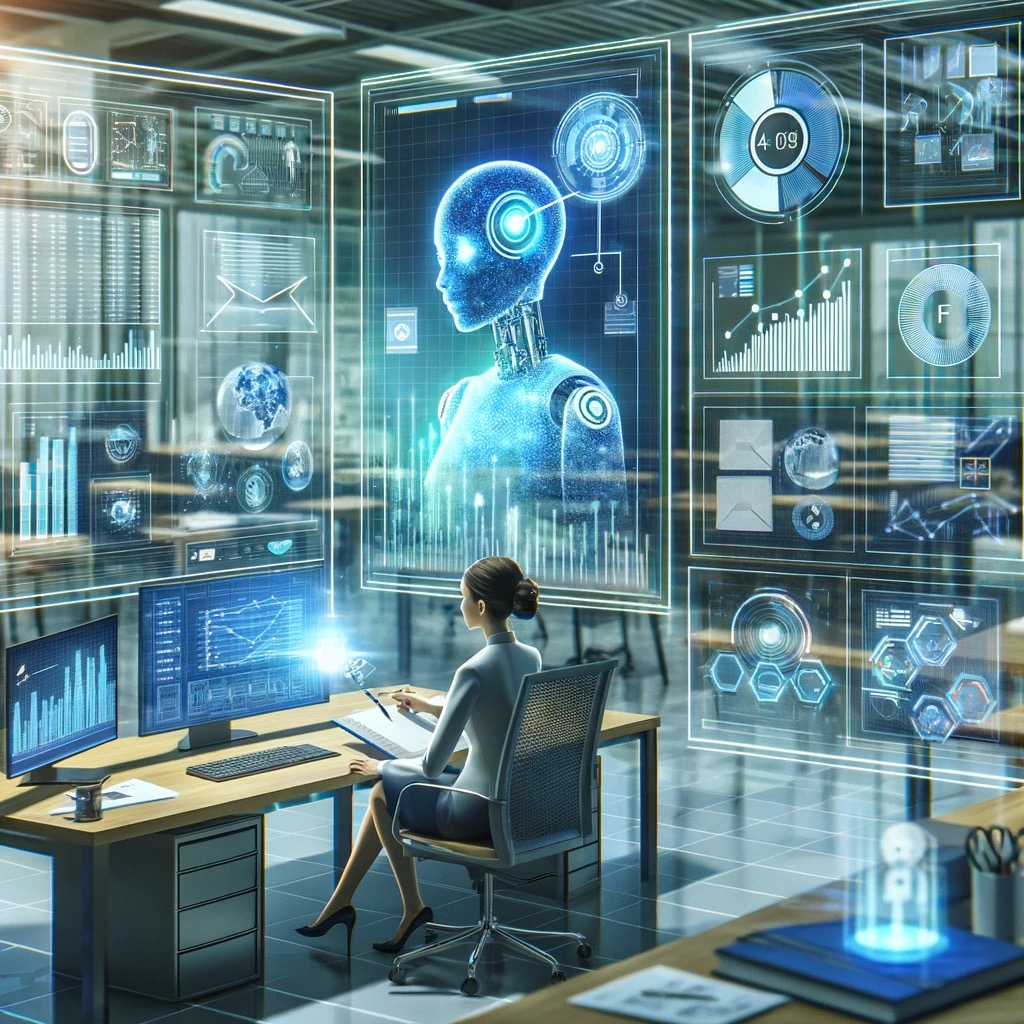
The future relationship between AI and education will be characterized by collaboration. AI will serve as a tool to enhance rather than replace the human elements of teaching and learning.
Educators will increasingly become facilitators of AI-driven learning experiences, guiding students through AI-enhanced educational environments while fostering critical thinking, creativity, and social skills.
The transformative impact of AI in education heralds a future where learning is more personalized, accessible, and engaging.
As AI technologies continue to evolve, their integration into educational settings can significantly enhance teaching and learning outcomes.
However, realizing this potential will require careful consideration of ethical implications, equitable access, and the balance between technology and human interaction.
Encouraging continuous innovation and responsible AI integration will be vital in shaping an educational future that leverages the best of what AI can offer while preserving the core values and experiences that define quality education.
8. Conclusion: AI’s Transformative Impact on Education

The exploration of Artificial Intelligence (AI) in education has unveiled its profound capacity to revolutionize teaching, learning, and administrative processes, marking a significant leap toward a future where education is more personalized, accessible, and efficient.
From enhancing customized learning experiences to automating administrative tasks and augmenting teaching methods, AI’s integration into educational settings demonstrates a transformative shift in how educational content is delivered and managed.
AI’s introduction into education has highlighted the technology’s potential to tailor learning experiences to individual student needs, providing adaptive learning paths that enhance engagement and comprehension.
Moreover, AI-driven tools have shown promise in reducing educators’ administrative burdens, allowing them to devote more time to interactive teaching and personalized student support.
In assessment and grading, AI offers objective, timely, and insightful feedback, improving the quality of educational evaluations.
However, AI’s journey in education is accompanied by challenges, including ethical considerations around data privacy, access inequality, and the preservation of human elements in teaching and learning.
Addressing these challenges through responsible AI development, transparent policies, and inclusive practices is crucial for maximizing AI’s benefits in educational environments.
Encouraging Continuous Innovation and Responsible AI Integration

The future of AI in education rests on the sector’s ability to innovate responsibly. Stakeholders, including educators, policymakers, technologists, and students, must collaborate to create an ecosystem that supports ethical AI development and deployment. This collaborative effort should focus on:
- Advancing AI Technology: Pushing the boundaries of AI to explore new applications and refine existing models, enhancing their effectiveness and accessibility in educational contexts.
- Fostering Ethical AI Practices: Developing ethical guidelines and standards for AI use in education, prioritizing student welfare, equity, and inclusion in AI applications.
- Embracing a Hybrid Approach: We must balance AI integration with traditional teaching methods to preserve the invaluable human interactions and mentorship that define quality education.
As AI in education is set to expand, offering innovative solutions to longstanding challenges and opening new avenues for teaching and learning.
The educational sector can leverage technology to enrich learning experiences and prepare students for success in an increasingly digital world by harnessing AI’s capabilities while navigating challenges with foresight and responsibility.
Encouraging continuous innovation and responsible integration of AI in educational settings will be vital to realizing this vision, ensuring that AI is a powerful tool for enhancing education for all.
FAQ & Answers
1. How is AI used in education?
AI is used to personalize learning experiences, automate grading and administrative tasks, enhance teaching methods, and improve educational administration.
2. What are the challenges of using AI in education?
Challenges include ensuring data privacy, addressing the digital divide, and finding the right balance between technology and traditional educational methods.
Quizzes
Quiz 1: “AI in Education” – Identify AI applications in different educational scenarios.
For a quiz on “AI in Education,” we’ll explore different AI applications and match them to various educational scenarios. This quiz will demonstrate how artificial intelligence can facilitate personalized learning, automate administrative tasks, enhance interactive learning, and provide real-time insights into student performance.
AI Technologies:
- Adaptive Learning Systems
- Natural Language Processing (NLP)
- Machine Learning (ML)
- Data Mining
- Intelligent Tutoring Systems
- Speech Recognition
- Virtual Reality (VR)
Educational Scenarios:
A) Personalized Learning Paths: Customizing learning experiences according to the individual needs, strengths, and weaknesses of each student. B) Automated Essay Scoring: Rapid and unbiased grading of essays based on linguistic and content quality. C) Predictive Analytics: Using historical data to predict student outcomes and identify those who might need additional support. D) Voice-activated Assistants: Enhancing classroom and online learning environments by providing voice-driven interactions. E) Interactive Simulations: Providing immersive learning experiences that replicate real-world scenarios. F) Student Engagement Analysis: Evaluating student engagement through analysis of interaction data and learning patterns. G) Plagiarism Detection: Identifying cases of plagiarism in academic work using sophisticated content analysis.
Matches:
- Adaptive Learning Systems: A) Personalized Learning Paths – These systems use algorithms to adapt the content and pace according to the unique needs of each student, enhancing personalized learning experiences.
- Natural Language Processing (NLP): B) Automated Essay Scoring, G) Plagiarism Detection – NLP is utilized to automatically score essays by analyzing grammar, usage, mechanics, and the overall quality of arguments. It also helps detect plagiarism by comparing submissions against a database of known sources.
- Machine Learning (ML): C) Predictive Analytics, F) Student Engagement Analysis – ML algorithms analyze past student data to predict future performance and outcomes. They are also used to assess levels of student engagement by examining interaction patterns and behaviors in learning platforms.
- Data Mining: C) Predictive Analytics – Data mining techniques extract insights from large sets of educational data, helping educators understand and predict student success and challenges.
- Intelligent Tutoring Systems: A) Personalized Learning Paths – These systems simulate one-on-one interaction between a student and a tutor by providing customized feedback and instructional guidance based on individual responses.
- Speech Recognition: D) Voice-activated Assistants – Speech recognition technology enables the development of voice-activated assistants that can understand and respond to spoken queries, facilitating interactive and accessible learning.
- Virtual Reality (VR): E) Interactive Simulations – VR technology is used to create realistic and engaging simulations that allow students to experience and interact with complex subjects in a hands-on and immersive manner.
These matches show how AI technologies are applied across various educational scenarios, offering significant benefits from administrative efficiencies to enhanced learning experiences. This integration of AI helps educators better meet the diverse needs of students while providing interactive and personalized learning environments.
Quiz 2: “Innovations in AI-Driven Education” – A quiz on recent AI innovations in the education sector.
For a quiz on recent AI innovations in the education sector, I’ll craft questions that highlight cutting-edge developments and applications of artificial intelligence that are transforming educational methodologies and improving both teaching and learning experiences.
Question 1: Adaptive Learning Environments
What is a key innovation of AI in adaptive learning environments?
A) AI has completely replaced teachers in classrooms.
B) AI tailors learning experiences to match the unique needs of each student, adjusting content and pacing accordingly.
C) AI enforces a standardized curriculum for all students without variation.
D) AI randomly assigns educational content to create variety.
Question 2: AI in Educational Assessment
How is AI changing the way educational assessments are conducted?
A) By making all assessments multiple choice.
B) AI is not involved in educational assessments.
C) By using NLP to conduct real-time spoken language assessments.
D) By limiting assessments to computer-based tests only.
Question 3: Virtual Reality in Education
What role does AI-enhanced virtual reality (VR) play in education?
A) VR with AI is primarily used for gaming in schools.
B) VR driven by AI creates immersive, interactive learning scenarios that help students understand complex concepts through experience.
C) VR replaces all traditional educational tools.
D) AI uses VR to simulate standardized tests.
Question 4: AI-Powered Tutoring Systems
What advantage do AI-powered tutoring systems provide over traditional tutoring?
A) They provide 24/7 availability and personalized feedback based on individual student performance.
B) They discourage students from asking questions to streamline learning.
C) Such systems only offer tutoring in mathematics.
D) They require constant internet connectivity to function.
Question 5: Machine Learning in Curriculum Development
How is machine learning utilized in curriculum development?
A) To copy existing curricula from top-performing schools.
B) Machine learning analyzes vast amounts of educational data to identify trends and effectiveness, helping to shape more effective curricula.
C) It is used to decrease the diversity of curriculum offerings.
D) Machine learning simplifies curricula to basic literacy and numeracy skills.
Question 6: Natural Language Processing (NLP) in Language Learning
What is a significant application of NLP in language learning?
A) NLP transcribes books into languages instantly without errors.
B) It is used to translate teacher instructions into multiple languages automatically.
C) NLP supports real-time language translation and grammatical analysis to aid language learning.
D) NLP prevents the use of any language other than English.
Question 7: Predictive Analytics in Student Support Services
What role does predictive analytics play in student support services?
A) Predictive analytics has no place in student services.
B) It is used to predict when students will need specific academic resources, allowing preemptive support.
C) Predictive analytics suggests students should not change their learning habits.
D) It only predicts student sports performance.
These questions explore the innovative applications of AI across different aspects of the educational sector, showcasing how these technologies are significantly enhancing learning environments, personalizing student interactions, and optimizing educational outcomes.
Here are the answers to the quiz on recent AI innovations in the education sector:
Question 1: Adaptive Learning Environments
Correct Answer: B) AI tailors learning experiences to match the unique needs of each student, adjusting content and pacing accordingly. AI in adaptive learning environments dynamically adjusts educational content and pacing based on the individual learning styles, pace, and needs of students, providing a personalized learning experience.
Question 2: AI in Educational Assessment
Correct Answer: C) By using NLP to conduct real-time spoken language assessments. AI is revolutionizing educational assessments by utilizing natural language processing (NLP) to perform sophisticated analyses like real-time spoken language assessments, enhancing the accuracy and scope of evaluations.
Question 3: Virtual Reality in Education
Correct Answer: B) VR driven by AI creates immersive, interactive learning scenarios that help students understand complex concepts through experience. AI-enhanced virtual reality (VR) plays a crucial role in education by creating highly immersive and interactive learning environments that enable students to understand and engage with complex subjects through experiential learning.
Question 4: AI-Powered Tutoring Systems
Correct Answer: A) They provide 24/7 availability and personalized feedback based on individual student performance. AI-powered tutoring systems offer significant advantages such as 24/7 availability and personalized instruction tailored to individual performance metrics, far exceeding the flexibility of traditional tutoring methods.
Question 5: Machine Learning in Curriculum Development
Correct Answer: B) Machine learning analyzes vast amounts of educational data to identify trends and effectiveness, helping to shape more effective curricula. Machine learning is used in curriculum development to analyze educational data, identify learning trends, and assess the effectiveness of various teaching methods and materials, thereby informing the development of more effective curricula.
Question 6: Natural Language Processing (NLP) in Language Learning
Correct Answer: C) NLP supports real-time language translation and grammatical analysis to aid language learning. Natural language processing facilitates language learning by supporting real-time translation and grammatical analysis, which enhances learning efficiency and helps students understand and use new languages more effectively.
Question 7: Predictive Analytics in Student Support Services
Correct Answer: B) It is used to predict when students will need specific academic resources, allowing preemptive support. Predictive analytics plays a vital role in student support services by forecasting students’ needs for academic resources, enabling educational institutions to provide timely and preemptive support that enhances student success.
These answers highlight how AI is significantly improving various aspects of the education sector, from personalizing learning and optimizing curricula to enhancing assessments and support services. These innovations not only streamline educational processes but also greatly enrich the learning experience.

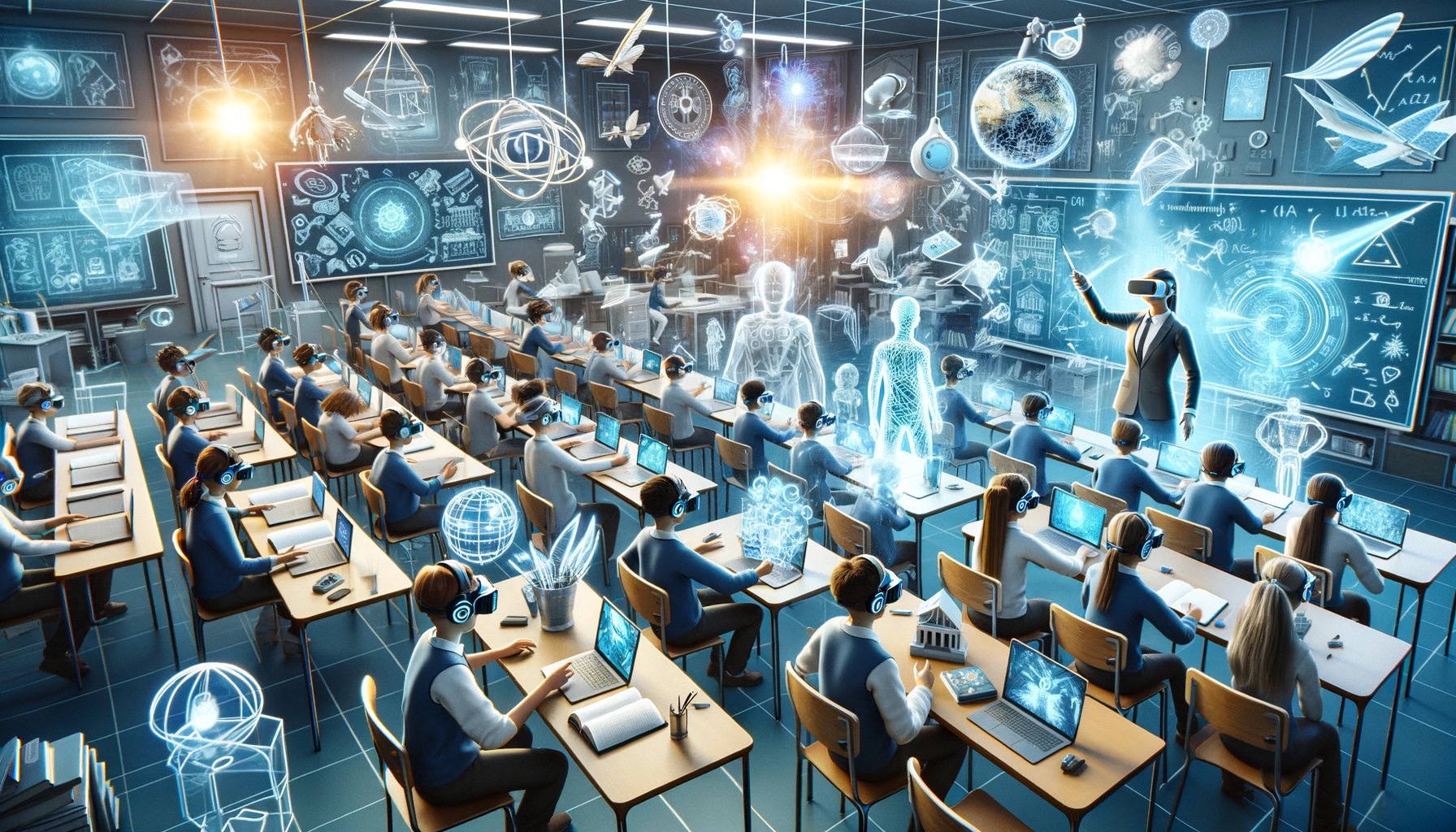



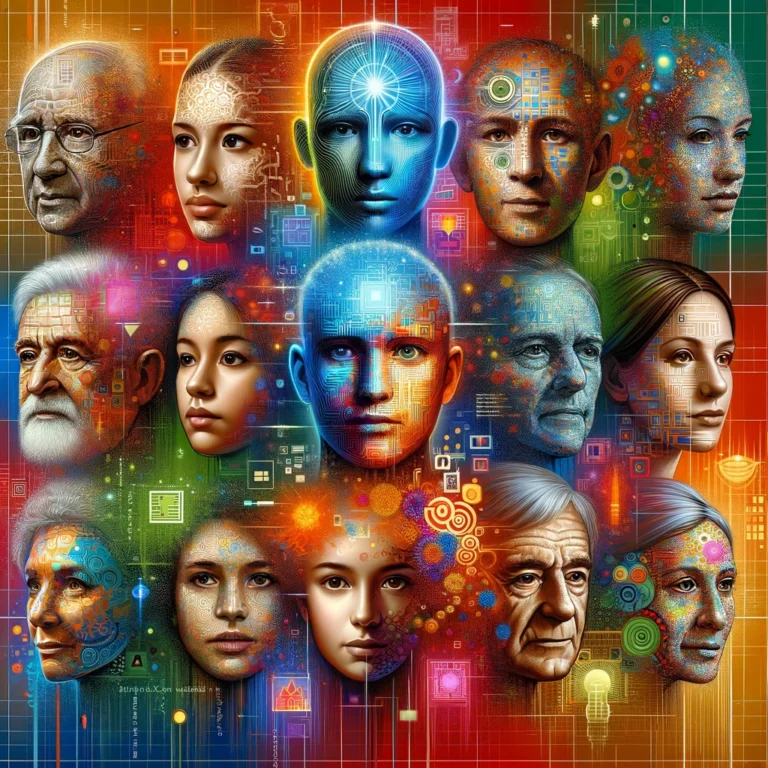
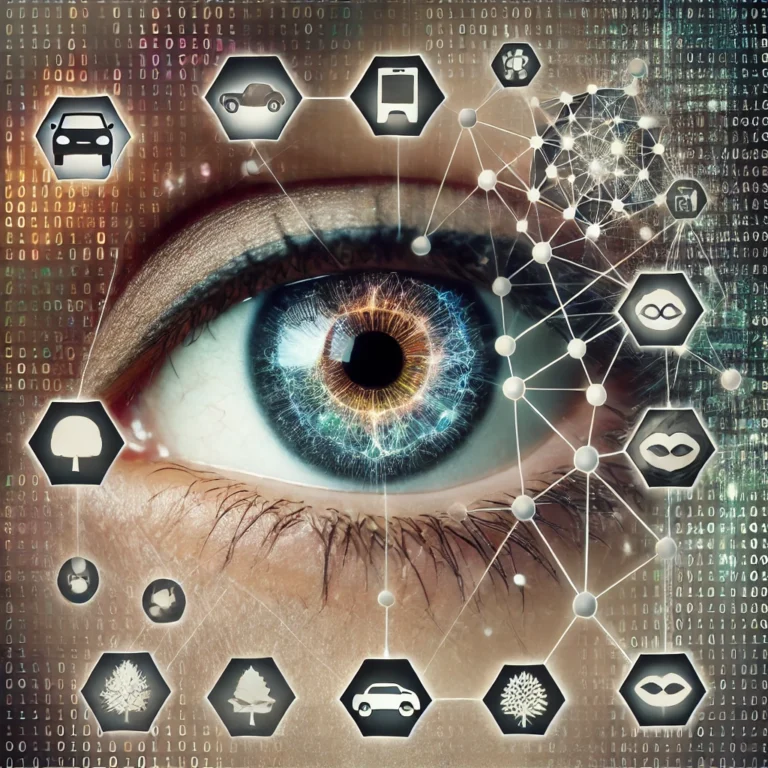

Many people today are increasingly interested in subjects like Artificial intelligence because of their major influence on global technology and financial systems. At the same time, the rise of markets such as Insurance attracts individuals who want to explore new opportunities and learn how digital economies operate. Others choose to study areas like Forex to understand long‑term strategies, risk management, and potential growth across different sectors.